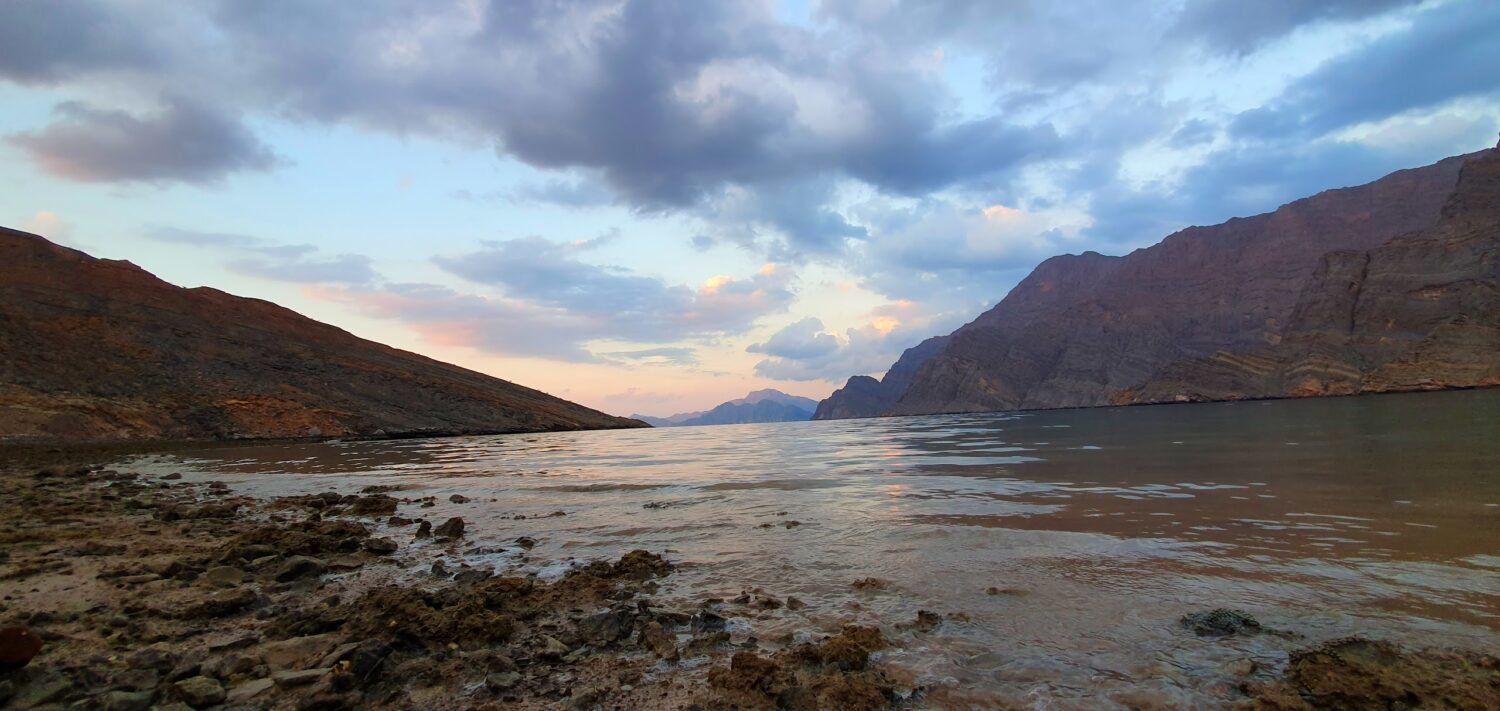
Khasab, a hidden gem in Oman, presents an ideal climate for travelers seeking both adventure and natural beauty. From October to March, temperatures fluctuate between 20°C and 30°C, making outdoor activities enjoyable with minimal rainfall.
The winter months, particularly from November to March, bring gentle showers that rejuvenate the landscape, creating perfect conditions for trekking and wildlife observation.
Summer can be intense, with temperatures soaring above 40°C, yet this heat invites refreshing water-based activities. Travelers often opt for the shoulder months of April and October for a more serene experience.
How can understanding Khasab’s climate enhance your travel plans? Knowledge of the best times to visit ensures you relish the stunning scenery and activities with fewer crowds.
Khasab Climate: A Detailed Overview

Khasab’s tropical desert classification underpins its weather patterns, highlighting the region’s climate. Average temperatures shape the climatic experience in this area.
Summer months experience particularly high temperatures, with averages ranging from 30°C to 40°C (86°F to 104°F). In contrast, the winter period offers respite, with averages of 20°C to 30°C (68°F to 86°F). These figures reveal a significant thermal variance, suggesting preparation is crucial before visiting.
Preparation is crucial, as temperatures vary from 20°C in winter to a scorching 40°C in summer.
Precipitation is minimal, with most rainfall occurring during winter. Khasab’s average annual precipitation totals just 185 mm, concentrated mainly from December to March. Traveling during the winter months can be more enjoyable due to milder temperatures.
Informed travelers should integrate these climate metrics when planning trips. Our team at Gulf Musandam Tours recommends considering these seasonal details when choosing the perfect time for your visit. Feel free to call us for personalized advice.
Understanding Khasab’s Seasonal Weather Patterns
In Khasab, seasonal patterns show mild winter temperatures, ranging from 20°C to 30°C, alongside higher precipitation, particularly in February with 49.1 mm of rain. In the summer months, particularly June through August, temperatures often exceed 40°C.
The optimal time for outdoor activities and travel is from October to March, coinciding with the cooler, more pleasant climate and peak tourist season. Additionally, understanding the temperature and weather conditions in Musandam can significantly enhance your travel experience.
Winter and Rainy Months Insights
While Khasab is known for its hot summers, the winter months from November to March bring a refreshing change with pleasant daytime temperatures ranging from 20°C to 30°C (68°F to 86°F). Weather tracking indicates that Khasab receives most of its annual rainfall during these months, averaging 185 mm.
February sees the peak of the rainy season with 49.1 mm. January’s mild average of 20.8°C is ideal for outdoor exploration. Light showers during the winter months not only refresh the area but also enhance the lush scenery.
These conditions are optimal for trekking, wildlife spotting, and exploring Khasab’s remarkable fjords and historical sites. Additionally, the best time to visit Musandam coincides with these winter months, allowing travelers to enjoy the region’s stunning landscapes. For those interested, you can explore our Musandam mountain safari tours to make the most of these ideal months. You can call us anytime for assistance or bookings.
Experience Khasab’s Intense Summer Temperatures
Khasab experiences exceptionally high summer temperatures, often exceeding 40°C (104°F) from April through October. During this period, daytime temperatures generally remain between 30°C and 40°C (86°F to 104°F), leaving little room for cooler weather.
The severe heat, coupled with humidity levels that can reach 90%, makes outdoor activities challenging.
- Continuous sunlight heats the streets intensely
- Heatwaves create shimmering effects across the desert landscape
- High humidity envelops coastal regions
- Temperature peaks often reach 46/47°C (115/117°F) during the height of summer
Plan activities for early mornings or late evenings to better manage Khasab’s extreme temperatures and find pleasant weather periods. Visiting during scheduled Musandam tours can enhance your experience in the region. Our dhow cruise tours offer a refreshing way to enjoy the sea breeze during these hotter months. Call us at +971 50 756 5063 to learn more about these options.
Optimal Seasons for Visiting Khasab
The best time to visit Khasab is between October and March when mild temperatures range from 15°C to 25°C (59°F to 77°F). These months provide excellent conditions for outdoor activities, including exploring fjords and historical sites.
From May to September, the high temperatures, exceeding 40°C (104°F), restrict outdoor activities to cooler times of the day. April and October, as transitional months, offer mild weather with fewer tourists.
The rainy season, which lasts from January to March, transforms Khasab into a verdant landscape with stunning vistas. This period is also ideal for scheduling Musandam excursions, allowing a full appreciation of the area’s natural and cultural attractions. Feel free to contact us at +971 50 756 5063 to find the perfect tour package that suits your travel dates.
Analyzing Khasab’s Temperature Variations
An analysis of Khasab’s climate reveals noticeable seasonal temperature fluctuations. January’s average temperature remains a comfortable 20.8°C, whereas July experiences scorching conditions, averaging 35.3°C.
From April to October, intense heat prevails, frequently exceeding 40°C and reaching peaks of 46/47°C during the hottest months. Winter brings relief with temperatures between 20-30°C, ideal for outdoor activities.
Consider these key temperature observations in Khasab:
- Mild January: 20.8°C
- Intense July Heat: 35.3°C
- Summer Peaks (June-August): 46/47°C
- Comfortable Winters: 20-30°C
Furthermore, the region’s varied landscape, coupled with the climate, enhances Khasab’s allure to visitors. Its diverse temperatures contribute to a uniquely engaging environment. Explore our services and consider booking our dhow cruise tour for a unique perspective on the area. Contact us at +971 50 756 5063 to discuss your plans.
Rainfall Patterns and Precipitation Observations

The rainfall in Khasab is notably seasonal, with around 185 mm of total precipitation occurring mainly between December and March. February emerges as the peak month for rain with an average of 49.1 mm, while June, August, September, and October show no precipitation.
Brief rainy days typically bring either light showers or occasional winter thunderstorms, contributing to short but lush seasonal changes in the region’s landscape.
Distinct Seasonal Rainfall Trends
Although Khasab is classified under a desert climate, its seasonal rain patterns add to its natural allure. The area receives around 185 mm of yearly precipitation, concentrated mainly from December to March.
February is recognized as the wettest month, gathering close to 49.1 mm of rainfall.
Despite the overall sparseness of rain, its effects visibly alter the landscape. During the rainy season:
- The terrain becomes covered in lush greenery
- Light showers sustain a delicate natural balance
- Occasional thunderstorms animate the skies
- Desert landscapes transform into captivating vistas
These elements contribute to each visit to Khasab being distinctive. We invite you to explore our customized Musandam tours that highlight these seasonal transformations beautifully. Remember, you can call us anytime for tailored travel advice.
Comparison of Wet and Dry Months
The rainfall patterns in Khasab demonstrate a distinct difference between its wettest and driest months. February, identified as the wettest month, receives an average of 49.1 mm of rain, representing the height of the rainy period.
On the other hand, during the driest months—June, August, September, and October—there is no recorded rainfall, highlighting the severity of the desert climate in the summer. With an annual average precipitation of around 185 mm, the rain predominantly occurs from December to March.
Rain often comes as short-lived storms during winter months, whereas from April to October, the extended period remains extremely dry with minimal precipitation.
Best Seasons for Visiting Khasab

For planning a visit to Khasab, target the months from October to March for an optimal experience. These months feature cooler temperatures ranging from 15°C to 25°C (59°F to 77°F), providing the ideal conditions for outdoor activities and local exploration.
April and October represent shoulder seasons, delivering pleasant climates and fewer tourists, suitable for a quieter getaway. Conversely, the primary tourist season encourages vibrant exploration because of the inviting weather.
- Mild climate: Ideal for sightseeing
- Fjord exploration: Favorable conditions
- Cultural experiences: Easier access
- Fewer crowds: April, October serenity
Guests can explore various tours and activities that highlight the Musandam Peninsula’s natural beauty and cultural heritage during these months. Explore our extensive tour packages and feel free to call us for recommendations tailored to your interests and schedule.
Seasonal Activities and Adventures in Khasab
Maximizing your Khasab experience involves engaging in activities influenced by seasonal weather. During warmer tropical desert months, with sea temperatures rising to 32.5 °C, the Gulf of Oman is perfect for swimming and diving among coral reefs.
October to March offers prime conditions for boat tours, exploring fjords, and observing marine life due to cooler temperatures.
Beach relaxation suits warm weather, while cooler months present trekking opportunities in the Musandam Peninsula or wildlife viewing. Musandam’s stunning scenic attractions offer an excellent backdrop for adventures. Plan outdoor activities thoughtfully; between May and September, avoid midday heat exceeding 40 °C by opting for fishing at dawn or dusk.
Packing Recommendations for Khasab’s Weather
Summer temperatures in Khasab often surpass 40°C, so packing efficiently ensures comfort and readiness. Choose lightweight, breathable cotton or linen clothing to manage the heat. In cooler mornings, layering clothes is beneficial.
Lightweight, breathable cotton or linen clothing guarantees comfort in Khasab’s intense heat.
Essentials for your Khasab journey include:
- Wide-brimmed hat: Provides sun protection.
- Reusable water bottle: Effectively prevents dehydration.
- Comfortable hiking shoes: Vital for exploring Khasab’s scenic landscapes.
- Warmer clothing: Required for cooler evenings from November to March.
Optimizing Weather Radar and Monitoring Tools
Using weather radar and monitoring tools is crucial for navigating Khasab’s dynamic climate efficiently. Real-time radar tracks storm movements and conditions, aiding in planning fishing trips or other outdoor activities.
The color-coded radar displays—green for light rain, yellow/orange for moderate, and red for severe weather—enable you to evaluate conditions quickly. Trusted weather radar services available on reputable apps and websites offer up-to-date local data.
Weather’s Effect on Khasab’s Natural Attractions
Despite limited rainfall, Khasab’s tropical desert climate greatly affects its natural attractions, influencing the timing and methods of exploration. These temperature changes impact the scenery and experiences throughout the year.
Summer heat rises above 40°C (104°F), reducing outdoor enjoyment without preparation. However, winter’s mild 20°C to 30°C (68°F to 86°F) temperatures provide comfort, ideal for fjords and historical sites.
Khasab’s climate fluctuations determine the optimal timing for experiencing its natural attractions and historical sites.
With most rain occurring from December to March, landscapes become vibrant, enhancing trekkers’ experiences in the Musandam Peninsula. Meanwhile, summer’s warm seas attract water enthusiasts, while winter cooling may appear less inviting.
- Expansive, rugged fjords
- Verdant hills after rain
- Crystal-clear snorkeling spots
- Active wildlife under mild skies
Final Thoughts
Khasab’s climate, with warm breezes and sporadic rain, offers an inviting atmosphere year-round. The mildest temperatures from December to February draw visitors eager to explore the stunning fjords and natural beauty of the region.
Understanding the weather patterns is essential for planning the perfect trip. By using weather radar tools, you can align your visit with ideal conditions, letting you appreciate Khasab’s majestic landscapes to the fullest.
Consider planning your adventure during the winter months. This timing offers comfortable weather and increased opportunities for memorable outdoor activities and sightseeing in Khasab’s breathtaking scenery.
Are you ready to explore the beauty of Khasab? Plan your visit today and experience the harmonious blend of nature and climate that makes this destination truly unique! Explore our dhow cruise tour for an unforgettable experience. Feel free to contact us at +971 50 756 5063 or reach out via email at in**@***************rs.com.

